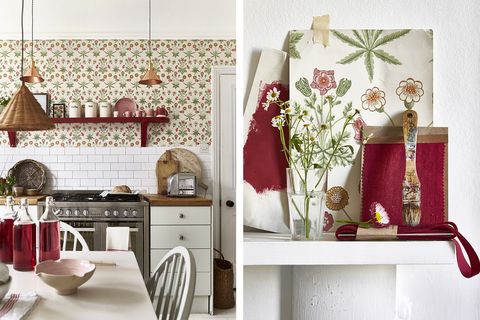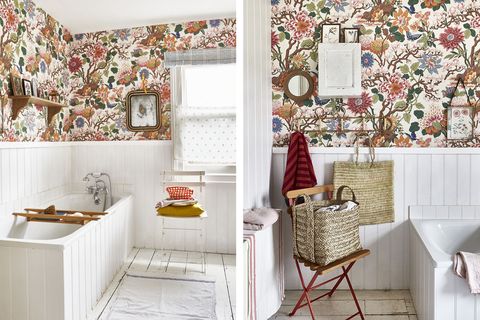
Photography: Rachel Whiting. Styling: Ben Kendrick
Decorating is becoming joyful again, after what feels like an eternity of simple, yet admittedly elegant, Scandi-inspired minimalism. The resurgence of bold pattern and cheerful colour used in abundance in our homes feels comforting, nostalgic, and optimistic – and it’s difficult to find a pattern more optimistic than florals.
Florals create a quintessentially country feel when used both in small accents or in great swathes. Here, we look at how best to use dainty daisy wallpaper in a kitchen, and how to zone and heighten with floral fabric, the ways in which to introduce dramatic and saturated rose motifs, and the best floral patterns for a crisp and clean bathroom.
Read on for four unique ways to decorate with some British floral favourites for a home that is always in bloom…
Roses in the living room
This sitting room takes its design queues from the country cottage playbook, with piles of mismatched accessories, a sink-in comfortable sofa, soft texture, and pretty colours. A quintessential country floral, roses make a happy companion here.
Bold florals in rich and saturated colours like these velvet cushions are most effective when used sparingly – they can still draw the eye even in a busy space. This design technique can be used on any number of small surfaces such as a lampshade, a runner, or a piece of wall art.
We ideally want our florals to be cheerful and uplifting, so take most care when using patterns with a dark background or in a heavy material – bright red roses can look wonderful on a black background, but it would feel dense and overwhelming in large doses.
Daisies in the kitchen
Nothing beats flowers for putting the ‘country’ into kitchens. An abundance of dainty florals has a lovely enveloping effect, creating the signature cosiness of a country kitchen and softening an otherwise functional space.
Here, an early William Morris print celebrates the humble daisy. Choose a colourful botanical illustration on a warming sepia-toned base if you want to achieve a similar vintage feel – classic enamel kitchen canisters, traditional spindle back dining chairs, and touches of industrial copper complement the effect.
When using a colourful wallpaper, don’t shy away from using colour elsewhere in your kitchen. Pick up the most cheerful tones and match them across furniture and accessories – a clever design treatment that is used so well on this cranberry-red kitchen shelf.
Hollyhocks in the bedroom
One for the tentative decorator. If you want to introduce floral patterns but are hesitant to do so in a big way, a wall-hanging or curtain is a safe option.
Hollyhocks tend to have a nostalgic and romantic quality, making them a good fit for a bedroom, here used so cleverly to zone and heighten the silhouette of the bed – this would work wonderfully too in the absence of a headboard.
A degree of informality is required when using such a pretty and feminine floral; country homes tend to be accessorised in a charming and casual way, and anything too neat can detract from a room well-lived and well-loved.
Magnolia in the bathroom
Magnolia is one of nature’s most precious but fleeting glories, and a joy to replicate indoors.
Big, energetic florals are well suited to a bathroom or cloakroom where they can be enjoyed in small doses. They are a great choice to liven up plain tiles, too.
When using a vibrant floral print in a wide colour palette, keep your surrounding features clean and crisp – the white tongue and grove panelling and painted floorboards here offset the big, blousy florals above. Exercise similar caution when selecting your bathroom accessories, one or two complementary shades is all you’ll need.
And don’t be put off by the idea of wallpaper peeling or bubbling in a steamy bathroom – it is more resilient than you may think. Just be sure to use water-resistant materials in those areas likely to be splashed.
This content is created and maintained by a third party, and imported onto this page to help users provide their email addresses. You may be able to find more information about this and similar content at piano.io




